Showing Spotlights 89 - 96 of 254 in category All (newest first):
 Carbon nanotubes (CNTs) being highly electrically conductive along the tube axis, have gained great research interests in recent years for connecting two conducting electrodes at the nanoscale - where the CNTs can be integrated into a micro- or nanoelectronic system. Therefore, the orientational control of CNTs has drawn a great deal of research interest in nanotechnology. Researchers now have developed a technique to bridge two electrical conductors by assembling CNTs guided by liquid crystals.
Carbon nanotubes (CNTs) being highly electrically conductive along the tube axis, have gained great research interests in recent years for connecting two conducting electrodes at the nanoscale - where the CNTs can be integrated into a micro- or nanoelectronic system. Therefore, the orientational control of CNTs has drawn a great deal of research interest in nanotechnology. Researchers now have developed a technique to bridge two electrical conductors by assembling CNTs guided by liquid crystals.
Nov 1st, 2016
 Researchers have created a new method to print high-performance electronics by combining the extremely mature CMOS fabrication processes and recently developed additive manufacturing techniques. For the first time, an affordable and reliable manufacturing process for the integration and packaging of fully flexible high-performance electronics has been developed for future Internet-of-Everything (IoE) applications. Such decal electronic systems could be used like RFID tags are today but with much more functionality and performance.
Researchers have created a new method to print high-performance electronics by combining the extremely mature CMOS fabrication processes and recently developed additive manufacturing techniques. For the first time, an affordable and reliable manufacturing process for the integration and packaging of fully flexible high-performance electronics has been developed for future Internet-of-Everything (IoE) applications. Such decal electronic systems could be used like RFID tags are today but with much more functionality and performance.
Oct 17th, 2016
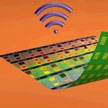 Researchers have developed a highly manufacturable integration strategy for making 3D flexible sensor arrays and connecting them to control electronics based on the widely popular phrase, 'Two sides of the same coin'. Sensor arrays and control elements for flexible electronics devices are usually placed on the same plane, unnecessary requiring additional area, and causing problems of heat dissipation. These challenges motivated researchers to come up with an area-efficient solution for the problem of connecting sensors and electronics together in such a way that electronics can be kept away from the sensed surface. This is the first time ever the concept of double sided flexible 3D electronics has been introduced in the flexible and wearable electronics industry.
Researchers have developed a highly manufacturable integration strategy for making 3D flexible sensor arrays and connecting them to control electronics based on the widely popular phrase, 'Two sides of the same coin'. Sensor arrays and control elements for flexible electronics devices are usually placed on the same plane, unnecessary requiring additional area, and causing problems of heat dissipation. These challenges motivated researchers to come up with an area-efficient solution for the problem of connecting sensors and electronics together in such a way that electronics can be kept away from the sensed surface. This is the first time ever the concept of double sided flexible 3D electronics has been introduced in the flexible and wearable electronics industry.
Jul 26th, 2016
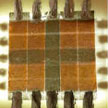 Using multilayer graphene as an electrically reconfigurable optical medium, researchers have demonstrated an optoelectronic framework compatible with conventional printing paper. The device consist of two multilayer graphene layers transfer-printed on both sides of the paper. In this configuration, multilayer graphene simultaneously operates as the electrically reconfigurable optical medium and electrically conductive electrodes. In addition, the paper substrate yields a flexible and foldable mechanical support for the graphene layers and it holds the electrolyte in the network of hydrophilic cellulose fibers.
Using multilayer graphene as an electrically reconfigurable optical medium, researchers have demonstrated an optoelectronic framework compatible with conventional printing paper. The device consist of two multilayer graphene layers transfer-printed on both sides of the paper. In this configuration, multilayer graphene simultaneously operates as the electrically reconfigurable optical medium and electrically conductive electrodes. In addition, the paper substrate yields a flexible and foldable mechanical support for the graphene layers and it holds the electrolyte in the network of hydrophilic cellulose fibers.
Jun 8th, 2016
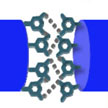 Not all electrocapacitive materials are intrinsically stretchable and various modified structures and electron/ion-inactive stretchable substrates have been utilized to introduce stretchability into conventionally rigid supercapacitors. Now, researchers have developed a multifunctional polyelectrolyte, achieving an electrochemically complete self-healability and 600% stretchability of supercapacitors. This work can be applied to other energy conversion and storage devices such as batteries, fuel cells, etc.
Not all electrocapacitive materials are intrinsically stretchable and various modified structures and electron/ion-inactive stretchable substrates have been utilized to introduce stretchability into conventionally rigid supercapacitors. Now, researchers have developed a multifunctional polyelectrolyte, achieving an electrochemically complete self-healability and 600% stretchability of supercapacitors. This work can be applied to other energy conversion and storage devices such as batteries, fuel cells, etc.
Feb 22nd, 2016
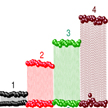 Resistive random access memory (RRAM) is envisioned as a next generation non-volatile memory because of the simple device geometry, ease of fabrication and operation. The necessity of high-density information storage and its relevance in neuromorphic circuitry has gained much attention and led to the development of multilevel resistive switching (MRS) for multiple memory states. In a recent study, researchers have defined a new figure-of-merit to identify the efficiency of resistive switching devices with multiple memory states. This will assist researches as well as technologist in classifying and deciding the true merit of their memory devices.
Resistive random access memory (RRAM) is envisioned as a next generation non-volatile memory because of the simple device geometry, ease of fabrication and operation. The necessity of high-density information storage and its relevance in neuromorphic circuitry has gained much attention and led to the development of multilevel resistive switching (MRS) for multiple memory states. In a recent study, researchers have defined a new figure-of-merit to identify the efficiency of resistive switching devices with multiple memory states. This will assist researches as well as technologist in classifying and deciding the true merit of their memory devices.
Feb 1st, 2016
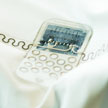 The future Internet of Things (IoT), with its intuitive applications, will operate based on an broad stream of data supplied by sensors placed everywhere. These will be sensors that are many times smarter and more sensitive than the ones we have today. They will also be produced and installed in far greater numbers and be much cheaper than they are now. For example, researchers envisage a radar that is capable of distinguishing pedestrians from cyclists. That technology might even allow to identify individuals from the way they walk.
The future Internet of Things (IoT), with its intuitive applications, will operate based on an broad stream of data supplied by sensors placed everywhere. These will be sensors that are many times smarter and more sensitive than the ones we have today. They will also be produced and installed in far greater numbers and be much cheaper than they are now. For example, researchers envisage a radar that is capable of distinguishing pedestrians from cyclists. That technology might even allow to identify individuals from the way they walk.
Jan 18th, 2016
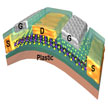 In the past, the performance of synthesized MoS2 had been poor, especially when integrated on flexible substrates. A new study have now yielded the highest performance for CVD-grown monolayer MoS2 device properties on flexible substrates to date. MoS2 exhibits unique physical, optical and electrical properties correlated with its single-layer atomic layer structure. Important for electronics applications, and in contrast to graphene, MoS2 has a bandgap.
In the past, the performance of synthesized MoS2 had been poor, especially when integrated on flexible substrates. A new study have now yielded the highest performance for CVD-grown monolayer MoS2 device properties on flexible substrates to date. MoS2 exhibits unique physical, optical and electrical properties correlated with its single-layer atomic layer structure. Important for electronics applications, and in contrast to graphene, MoS2 has a bandgap.
Jan 6th, 2016
 Carbon nanotubes (CNTs) being highly electrically conductive along the tube axis, have gained great research interests in recent years for connecting two conducting electrodes at the nanoscale - where the CNTs can be integrated into a micro- or nanoelectronic system. Therefore, the orientational control of CNTs has drawn a great deal of research interest in nanotechnology. Researchers now have developed a technique to bridge two electrical conductors by assembling CNTs guided by liquid crystals.
Carbon nanotubes (CNTs) being highly electrically conductive along the tube axis, have gained great research interests in recent years for connecting two conducting electrodes at the nanoscale - where the CNTs can be integrated into a micro- or nanoelectronic system. Therefore, the orientational control of CNTs has drawn a great deal of research interest in nanotechnology. Researchers now have developed a technique to bridge two electrical conductors by assembling CNTs guided by liquid crystals.
 Subscribe to our Nanotechnology Spotlight feed
Subscribe to our Nanotechnology Spotlight feed





